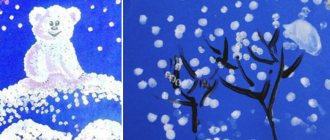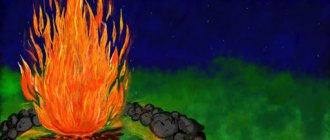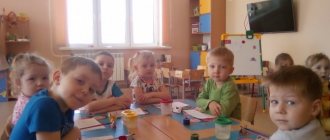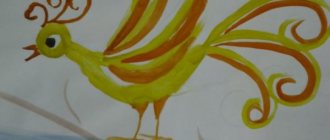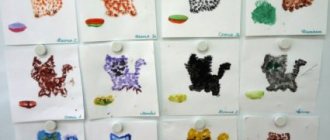Notes on drawing "Starry Sky" in the second group of early age
Yulia Gik
Notes on drawing "Starry Sky" in the second group of early age
Summary of a drawing lesson in the second early age group
«Starry sky»
Prepared by Gik Yulia Yurievna,
teacher of MBDOU d/s No. 46 “Firefly”
Pskov
Goal: introducing children to the unconventional finger painting .
1. Teach children to draw dots and round objects with their fingers.
2. Develop fine motor skills of the hands, attentiveness and accuracy when working.
3. Cultivate kindness and responsiveness.
Demonstration material. Toy – Luntik, foil star , pictures of the starry sky.
Handouts: black cardboard, small stars made of golden cardboard, glue stick, yellow gouache, rags.
Give the concept of parts of the day (morning, afternoon, evening, night)
.
Looking at pictures depicting the night starry sky , reading thematic poems and fairy tales, talking about the daily routine, introducing children to the fairy tale about Luntik.
Master class on unconventional drawing “I draw space” for middle school children
Nadezhda Kovalchuk
Master class on unconventional drawing “I draw space” for middle school children
Goal: creating conditions for the development of artistic and creative
children's abilities using non-traditional techniques of drawing the Cosmos
in distance learning conditions.
Tasks:
Introduce preschoolers to unconventional drawing - “splash” and “imprint”; develop the ability to work with non-traditional tools.
Develop children's creative abilities; fine motor skills.
To develop an aesthetic attitude towards Space and the planets of the solar system; sensitivity to the perception of the beauty of the surrounding world.
The master class “I draw Space” on non-traditional drawing consists of 2 stages
1. “Starry sky” (background) – we use the non-traditional painting technique of “spraying” and drawing with cotton swabs.
2. “Planets of the Solar System” - an unconventional “print” drawing technique with cutting elements.
First stage: “Starry sky” (background)
We prepare the necessary material:
• sheet of black cardboard A4;
• toothbrush and cotton swab;
• white, yellow (primary colors) and blue, purple (additional colors) gouache or watercolor;
• water and container for it;
• oilcloth or backing
Attention! For spraying, choose 2 paints: one of the main ones and one of the additional ones. Hold the brush over the sheet, facing away from you.
Step 1. Wet a toothbrush in water and paint it with white or yellow paint (not too thick and not too runny). And we run our finger along the bristles - we spray paint onto the black cardboard.
On the topic: methodological developments, presentations and notes
Software Content: Teach children to lightly press a finger on a small ball of plasticine and smear it in different directions on the cardboard. Develop fine motor skills of the hands. Demonstration.
· Expansion of vocabulary · Introduce children to the symbolism of constellations accepted by astronomers, cultivate a love of nature.
Dear colleagues, educational psychologists working in sensory rooms! I would like to share with you an idea on how to make a “Starry Sky” sensory panel for a relaxation area using available materials.
Summary of a correctional lesson on orientation in space on the topic “Starry Sky”.
The presentation contains photographs of elements of the solar system.
Drawing using the wet technique.
Non-traditional technique: candle + watercolor. Purpose: to cultivate an aesthetic perception of nature and its images using non-traditional artistic techniques; develop color perception and visual movement.
Source
Progress of the lesson:
Educator: - Our familiar cartoon character came to visit us today (shows Luntik)
- Who is this, guys
(children's answers)
Q: - He brought us a little star. But Luntik is sad for some reason. Let's ask him why? (children ask)
(Tale from the teacher on behalf of Luntik)
Q: — Luntik told me that he found a star that had fallen from the sky and was very upset because he could not attach the star back to the
sky . When can we see stars in the sky? (children's answers)
B: - That's right, at night. What's the sky like at night ? (children's answers)
B: - Yes, black, dark blue. What do we do at night (answers: sleep)
Q: - There is one family that does not sleep at night, but walks, but not on the earth, but in the sky.
On clear nights, a mother and her daughters walk.
She doesn’t tell her daughters:
- Go to bed, it's late!
Because mother is the moon
Well, the daughters of the stars .
Q: — Sometimes instead of the mother moon and her daughters, a father called the moon walks across the night sky.
A month, a month, my friend,
You rise in deep darkness,
And, loving your custom,
The stars are looking at you.
(the teacher shows pictures of the starry sky with the moon and the month)
Q: — Guys, can we help Luntik return the star to the sky ? (children's answers)
Please come to the tables
(children sit down)
.
Q: - Before we start work, we will stretch our fingers.
fell asleep and suddenly
Lighted up everything around.
(sitting at the tables, raise your arms up with support on your elbows, clench your fingers into fists and unclench them, spreading them out like a fan and clench them again)
Q: - Now we will take black cardboard, this will be our night sky , and we will draw a round yellow moon on it, and put many dots around it with our fingers - these will be our stars. (After the demonstration by the teacher, the children begin to work. If necessary, the teacher helps the children)
Q: — So night came, the stars lit up in the sky. Now we can return the star that Luntik found to the sky (children attach a foil star to their sky )
Q: - Look how happy Luntik was! Now he will go out and admire her before going to bed!
The teacher praises the children for their work. Children, together with the teacher, look at drawings of the starry sky .
The teacher reads the poem:
The sky in the stars is beautiful!
There's no way to count it!

